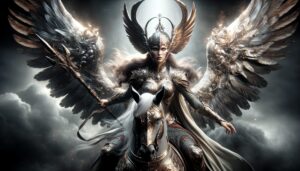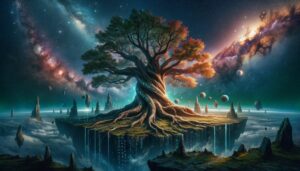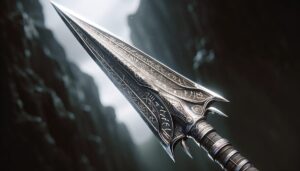Table of Contents
Runes, the enigmatic script of the ancient Norse, possess a unique blend of linguistic, cultural, and mystical significance. These characters, more than mere letters, are the key to unlocking a treasure trove of knowledge about the people who used them, their beliefs, and their connection to the supernatural. In this exploration of runes, we will delve into their origins, their linguistic properties, their cultural importance, and the magical aura that surrounds them.
Origins
The origins of the runic script remain shrouded in mystery, much like the runes themselves. The runic alphabets have their roots in the early Germanic symbols, but their exact beginnings are still debated among scholars. The Elder Futhark, the oldest known runic alphabet, appeared around the 2nd century CE and consisted of 24 characters. These characters evolved over time, eventually leading to various runic scripts like the Younger Futhark and the Anglo-Saxon Futhorc.
The Family
To understand the runes fully, we must examine their family tree. The runic alphabets are divided into several groups, each with its unique set of characters. The Elder Futhark, the oldest and most widely recognized, is the progenitor of many other runic scripts, including the Younger Futhark and the Anglo-Saxon Futhorc.
Appearance
Each runic character has a distinctive shape and name. For example, the rune “Fehu” looks like an “F” and represents cattle, wealth, and abundance. “Thurisaz,” resembling a thorn or arrow, signifies a giant or a force of chaos. These symbols were not only used for writing but also had profound cultural and mystical significance. The runic inscriptions often adorned various objects, from gravestones to jewelry, emphasizing their importance in daily life.
The Mystical Power of Runes
One of the most fascinating aspects of runes is their association with the mystical and magical. Runes were not just a means of communication; they were believed to possess inherent magical properties. People used runic symbols for divination, spellcasting, and protective charms. Each rune had specific meanings and associations, making them potent tools in the hands of those who understood their secrets.
Symbols Representing Runes
Runes themselves are symbols, but they also hold specific symbolic meanings. For example, “Algiz,” which resembles the letter “Z” with additional branches, is associated with protection and defense. It symbolizes the power to ward off danger. “Ansuz,” shaped like a capital “F” with diagonal lines, represents communication, divine inspiration, and wisdom.
The Cultural Impact of Runes
Runes are not just ancient relics but enduring symbols of Norse and Germanic culture. They evoke images of Viking warriors, sagas of old, and the mysticism of the Northern lands. Runes are frequently used in modern Norse and Viking-themed art, jewelry, and tattoos, serving as a link to the rich heritage of these peoples.
Thematic Exploration
To truly appreciate the depth of runes’ significance, we must explore the themes they represent. These themes are interwoven with the runic characters, adding layers of meaning to their usage.
Divination and Guidance: The practice of runic divination involves casting lots or runes and interpreting their meanings. This act seeks guidance or insight into various aspects of life, reflecting humanity’s timeless quest for understanding and direction.
Protection and Magic: Runes were employed as protective amulets and charms, emphasizing the desire for safety and the belief in the power of symbols to ward off malevolent forces.
Communication and Wisdom: The rune “Ansuz” represents communication and divine inspiration. It symbolizes the pursuit of wisdom and knowledge, a fundamental aspect of Norse culture and the human experience.
Detailed Descriptions
Each runic character has its own unique qualities and symbolism. Let’s delve into a few prominent runes to grasp their significance:
Fehu (F): Shaped like the letter “F,” it represents cattle, wealth, and abundance. In a society dependent on agriculture and livestock, Fehu held great importance as a symbol of prosperity.
Thurisaz (Þ): Resembling a thorn or arrow, it signifies a giant or a force of chaos. Thurisaz warns of potential obstacles and challenges, urging caution and preparation.
Algiz (ᛉ): With its branches reaching upward, Algiz symbolizes protection and defense. It represents the power to ward off threats and maintain one’s integrity.
Ansuz (ᚨ): Shaped like a capital “F” with diagonal lines, Ansuz represents communication, divine inspiration, and wisdom. It encourages the pursuit of knowledge and the importance of effective communication.
Associated Myths and Stories
Runes find their place not only in the written word but also in the oral traditions and sagas of the Norse people. Several myths and stories feature runes and their profound significance:
Odin’s Sacrifice for Wisdom and Runes
In Norse mythology, Odin’s self-sacrifice on Yggdrasil’s branches is a legendary tale that reveals the depths of his commitment to acquiring knowledge and power. Known as the “Hanging of Odin” or the “Odinic Sacrifice,” this act of extreme devotion holds profound significance.
Odin’s motivation for this harrowing act was his insatiable thirst for wisdom and a desire to unlock the secrets of the cosmos. He sought to gain insight into the mysteries of existence, foresee his own fate, and attain the knowledge of the runes, the ancient symbols that held the essence of creation and magic. In his relentless pursuit of wisdom, Odin was willing to make the ultimate sacrifice.
Odin hung himself from the branches of Yggdrasil, the World Tree, for nine days and nights. During this excruciating ordeal, he was pierced by his own spear, Gungnir. This act symbolized his complete surrender to the quest for knowledge, as he gave up sustenance and comfort for the sake of his pursuit.
Despite the agony and suffering he endured, Odin did not die during his hanging on Yggdrasil. Instead, he achieved his goal of gaining profound insight. It was during this time that the runes revealed themselves to him, their secrets unveiled as he grasped the very fabric of reality. Odin emerged from this ordeal with newfound wisdom and power, forever altered by his sacrifice.
The Saga of the Volsungs
The Runic Poems
Ancient poems, including the Old English Rune Poem, play a crucial role in unraveling the intricate meanings and associations of runic characters, diligently preserving their profound cultural and symbolic importance. These poems, passed down through generations, serve as invaluable sources of knowledge, shedding light on the deeper significance of runes.
Furthermore, the Old English Rune Poem is a treasure trove of insights. It offers a comprehensive view of how the runic symbols were perceived and understood in the context of the culture they originated from. This poem, along with its counterparts in other languages, provides a window into the minds of the people who used runes in their daily lives.
In the Old English Rune Poem, each runic character is accompanied by a short stanza that poetically encapsulates its essence. These stanzas are not mere descriptions but intricate compositions that capture the essence of each rune’s symbolic power. For example, the stanza for the rune “Feoh” (F), associated with wealth, reads:
“Wealth is a comfort to all men; yet must every man bestow it freely, if he wish to gain honor in the sight of the Lord.”
This stanza not only defines the rune but also imparts wisdom about the nature of wealth and generosity, reflecting the cultural values of the time.
Additionally, the Old English Rune Poem provides a unique glimpse into the worldview of the people who relied on these symbols. It reveals their beliefs, concerns, and aspirations. The runes, as expressed in these poems, were not static symbols but living entities with distinct personalities and qualities.
The Revival of Runic Traditions
To understand the modern use of runes in Neopaganism, it is essential to recognize the revival of ancient traditions. Neopaganism, with its reverence for nature and ancient spirituality, has rekindled interest in runes as a means of connecting with the past. Transitioning from obscurity to prominence, runes have found a place in rituals, ceremonies, and divination practices within Neopagan communities.
Runic Divination and Guidance
One of the most common ways runes are utilized in Neopaganism is for divination and guidance. Transitioning from the historic casting of lots, modern practitioners often draw runes from a pouch and interpret their meanings. Each runic symbol carries its own message and wisdom, offering insights into questions about the future, personal growth, and spiritual development.
Runic Magic and Talismans
Runes have also become integral components of modern Neopagan magic and spellwork. Practitioners inscribe runic symbols on talismans, candles, and other magical tools to harness their inherent energies. The runes, with their rich history and associations, infuse these rituals with depth and purpose, creating a potent blend of tradition and contemporary spirituality.
Incorporation into Rituals and Ceremonies
Modern Neopagan rituals and ceremonies often feature the use of runes to invoke specific qualities or energies. Transition words like “furthermore” and “moreover” help explain how runes are integrated into these practices. For instance, the rune “Algiz” might be drawn or displayed to invoke protection and spiritual guidance during a ceremony, creating a deeper connection between the participants and the spiritual forces they seek to connect with.
FAQ
What is the history of runes?
Runes date back to at least the 2nd century CE and were used by Germanic tribes, including Vikings.
How were runes used historically?
Runes were used for writing inscriptions on various objects, casting lots for divination, and in magical practices.
What are the different runic alphabets?
There are several runic alphabets, including the Elder Futhark, Younger Futhark, and Anglo-Saxon Futhorc.
What do runes symbolize?
Runes symbolize various concepts, from everyday objects to abstract ideas, each with its own meaning.
Are runes still used today?
Yes, runes have experienced a revival and are used in modern Neopaganism for divination, magic, and spiritual purposes.
Can anyone learn to read runes?
Yes, runes can be learned by anyone interested in their history and symbolism, and many resources are available for study.
What is runic divination?
Runic divination involves casting runes and interpreting their positions and meanings to gain insights or guidance.
Are runes associated with any deities?
In Norse mythology, runes are often associated with Odin, the Allfather, who is said to have discovered them through a self-sacrificial ordeal.
Are there ethical considerations when using runes in modern practices?
Some believe that commercialization and cultural appropriation can raise ethical concerns, so it's important to approach runes with respect for their historical and cultural significance.




